
Question Number 158088 by Gbenga last updated on 31/Oct/21

$$\mathrm{1},\mathrm{2},\mathrm{3},\mathrm{4},\mathrm{5},\left({x}\right) \\ $$$${what}\:{is}\:{x}\:{note}\:{not}\:\mathrm{6} \\ $$
Commented by MJS_new last updated on 31/Oct/21

$${f}\left({n}\right)=\frac{{x}−\mathrm{6}}{\mathrm{120}}{n}^{\mathrm{5}} −\frac{{x}−\mathrm{6}}{\mathrm{8}}{n}^{\mathrm{4}} +\frac{\mathrm{17}\left({x}−\mathrm{6}\right)}{\mathrm{24}}{n}^{\mathrm{3}} −\frac{\mathrm{15}\left({x}−\mathrm{6}\right)}{\mathrm{8}}{n}^{\mathrm{2}} +\frac{\mathrm{137}{x}−\mathrm{762}}{\mathrm{60}}{n}+\mathrm{6}−{x} \\ $$$$\mathrm{input}\:{n}=\mathrm{6}\:\mathrm{and}\:\mathrm{the}\:\mathrm{desired}\:{x} \\ $$$$\mathrm{i}.\mathrm{e}. \\ $$$${x}=\mathrm{5}\:\Rightarrow\:{f}\left({n}\right)=−\frac{{n}^{\mathrm{5}} }{\mathrm{120}}+\frac{{n}^{\mathrm{4}} }{\mathrm{8}}−\frac{\mathrm{17}{n}^{\mathrm{3}} }{\mathrm{24}}+\frac{\mathrm{15}{n}^{\mathrm{2}} }{\mathrm{8}}−\frac{\mathrm{77}}{\mathrm{60}}{n}+\mathrm{1} \\ $$$${x}=\mathrm{6}\:\Rightarrow\:{f}\left({n}\right)={n} \\ $$$${x}=\mathrm{7}\:\Rightarrow\:{f}\left({n}\right)=\frac{{n}^{\mathrm{5}} }{\mathrm{120}}−\frac{{n}^{\mathrm{4}} }{\mathrm{8}}+\frac{\mathrm{17}{n}^{\mathrm{3}} }{\mathrm{24}}−\frac{\mathrm{15}{n}^{\mathrm{2}} }{\mathrm{8}}+\frac{\mathrm{197}}{\mathrm{60}}{n}−\mathrm{1} \\ $$$$... \\ $$
Answered by MJS_new last updated on 31/Oct/21

$$\mathrm{we}\:\mathrm{can}\:\mathrm{find}\:\mathrm{a}\:\mathrm{polynome}\:\mathrm{of}\:\mathrm{degree}\:\mathrm{5}\:\mathrm{for}\:\mathrm{any} \\ $$$${x}\in\mathbb{C},\:\mathrm{so}\:\mathrm{there}'\mathrm{s}\:\mathrm{no}\:\mathrm{unique}\:\mathrm{answer} \\ $$
